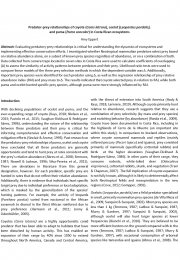- Resource Types
- Resource Languages
- Institutional Repository
 Visit the home page
Visit the home page
About Site Language
WHDL is viewable in multiple languages. Use the pull-down menu to select a language to view the site.
I changed my language, but I’m still seeing resources in the other languages?
If a resource or text has not been translated into your selected language, it will appear in the initially added language. We are always looking for help translating these resources. If you can help, contact us!
WHDL - 00011710


Evaluating predatory-prey relationships is critical for understanding the dynamics of ecosystems and implementing effective conservation efforts. I investigated whether Neotropical mammalian predators select prey based on relative abundance alone, on a subset of known prey species regardless of abundance, or on a combination of both. Data collected from camera traps located in seven sites in Costa Rica were used to calculate coefficients of overlapping (∆) to assess the similarity of activity patterns between predators and their prey. Likelihood ratio tests were used to compare linear models of the three prey selection methods in which the dependent variable was ∆. Additionally, important prey species were identified for each predator using ∆, as well as the regression relationship of prey relative abundance index (RAI) and prey mass to ∆. The results indicated that coyote selected prey in relation to RAI, while both puma and ocelot hunted specific prey species, although puma were more strongly influenced by RAI.
Arete: The PLNU Honors Journal
81 Resources
2020
2020
2022
2024
2023
2024
2023
2023
2021
2024